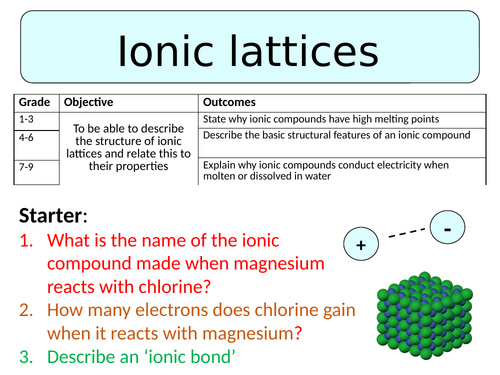
This lesson is designed for the NEW AQA Trilogy Chemistry GCSE, particularly the ‘Structure & Bonding’ SoW.
For more lessons designed to meet specification points for the NEW AQA Trilogy specifications for Biology, Chemistry and Physics please see my shop: https://www.tes.com/teaching-resources/shop/SWiftScience
The lesson starts with a set of questions on ionic compounds, pupils will watch a video and answer these questions. Then pupils will be shown a diagram to demonstrate the structure of a giant ionic compound and will be given a set of melting points for a range of ionic compounds, pupils will need to think > pair > share why they think the melting points of ionic compounds are so high. Once students have considered this, a class discussion can reveal some of the students ideas before the presentation moves on and explains why ionic compounds have high melting and boiling points. Students are now given a place-mat of questions, using information from the lesson so far they will need to complete part of it, for lower-ability students they may need extra support such as a text book to help them answer the questions. Once complete pupils can assess their work using the answers provided.
The next part of the lesson focuses on electrolysis using ionic compounds, students are shown that only ionic compounds that are molten or dissolved in water are able to conduct electricity. The process of electrolysis is demonstrated to students using an animation . Pupils are then asked to thin > pair > share their ideas on why ionic compounds that are solid cannot conduct electricity. Once some ideas have been discuss as a class, the answer can be revealed on the PowerPoint presentation. Pupils will now complete the remainder of their questions on their place-mat and mark them using the answers provided.
Pupils will now be given a set of ions and will need to decide whether they will be found at the positive or negative electrode, this activity can be done as a whole class by pupils holding up answers using whiteboards or in their books. Once completed students can assess their work using the answers provided. The last activity is for pupils to complete a cartoon strip to demonstrate what happens to molten potassium fluoride when it is used to conduct electricity. Part of the cartoon strip is filled in already, pupils just need to add in either diagrams or descriptions, this can also be assessed once complete.
The plenary task is a set of answers, pupils need to come up with a set of questions for these answers.
All resources are included at the end of the presentation. Thanks for looking, if you have any questions please let me know in the comments section and any feedback would be appreciated :)
Get this resource as part of a bundle and save up to 50%
A bundle is a package of resources grouped together to teach a particular topic, or a series of lessons, in one place.
Something went wrong, please try again later.
The content is really good an pretty well thought out. Just be mindful of the chemistry used in the presentation.
A well structured presentation with all worksheets required. Thanks
Report this resourceto let us know if it violates our terms and conditions.
Our customer service team will review your report and will be in touch.
